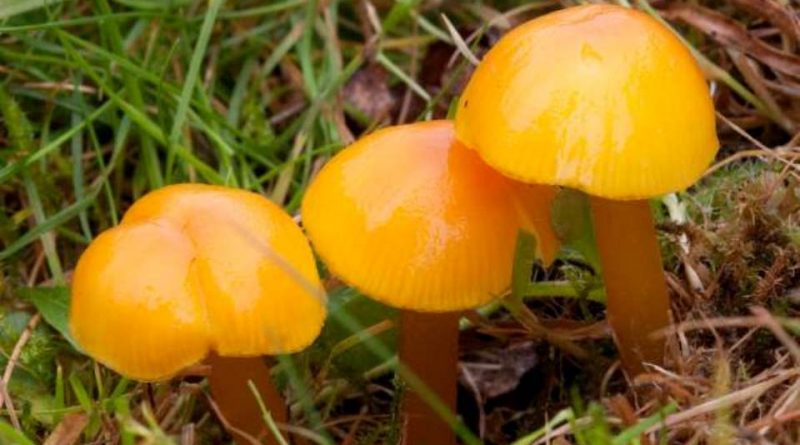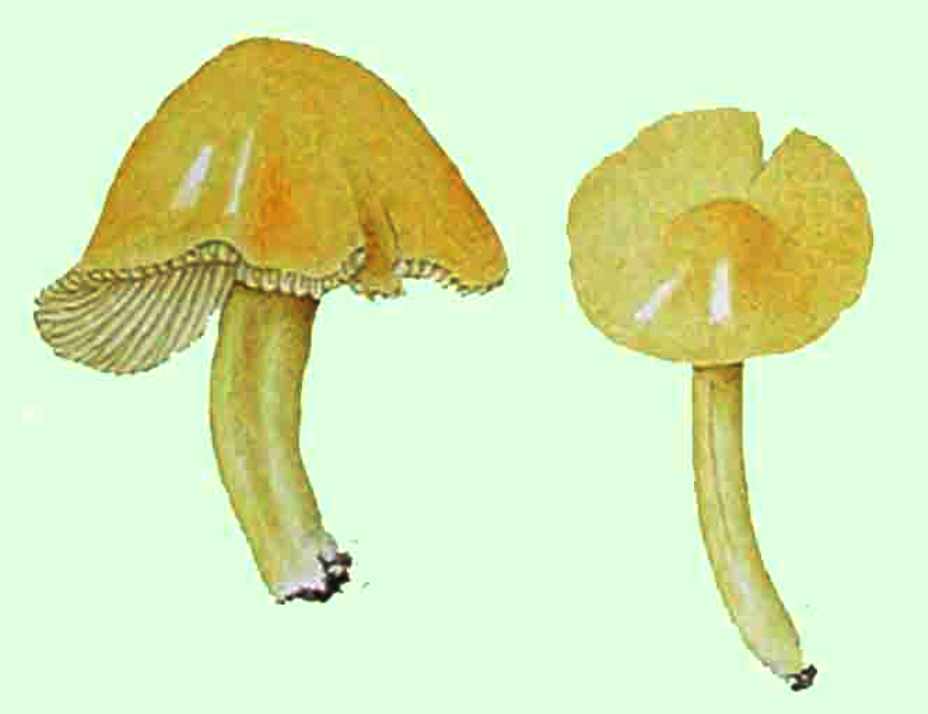Hygrocybe chlorophana
Hygrocybe chlorophana
The Golden waxcap (Hygrocybe chlorophana (Fr.) Wünsche, 1877) is a basidiomycete fungus from the family Hygrophoraceae.
Systematic –
From the systematic point of view it belongs to the Domain Eukaryota, Kingdom Fungi, Basidiomycota Division, Class Basidiomycetes, Order Agaricales, Family Hygrophoraceae and therefore to the Genus Hygrocybe and to the Specie H. chlorophana.
The terms are synonymous: Agaricus chlorophanus Fr .: Fr., Godfrinia chlorophana (Fr. Fr.) Herink, Hygrocybe chlorophana var. aurantiaca Bon, Hygrocybe euroflavescens Kühner, Hygrocybe flavescens (C.H. Kaufmann) Singer, Hygrophorus chlorophanus (Fr. Fr.) Fr. and Hygrophorus flavescens (C.H. Kaufmann) Smith & Hesler.
Etymology –
The term Hygrocybe comes from the Greek ὐγρός hygrόs moist and from κύβη cýbe head, hat: that is, with the wet hat. The specific epithet chlorophana comes from the Greek χλωρός chlorόs pale green and from the theme of the verb φαίνωμαι phaínomai appear: that is, a greenish appearance.
Geographic Distribution and Habitat –
Hygrocybe chlorophana grows in meadows, in pastures, gregarious, and is a very common species in the humid and muscular meadows of the foothills. The fruiting period ranges from summer to autumn.
Recognition –
The Hygrocybe chlorophana is recognized for having a cap with a diameter of up to 5 cm, convex to flat, with a smooth, non-hygrophanous surface, of an intense sulfur yellow, citrine yellow color, sometimes with orange hues and a thin cuticle. detachable only with small flaps. The lamellae are interspersed with numerous lamellae of different length, rather wide, attenuated to the stem, white, but tending to light yellow. The stem is about 5-7 cm long and 5-8 mm wide, cylindrical, often curved, slightly thickened at the base, smooth, with a slightly viscous surface that with the wet weather becomes moist and of the same color as the hat. The meat is very small, very thin in the hat, whitish and watery, with a peculiar smell and taste. Under the microscope there are ellipsoidal spores, smooth, white in mass, of 9 x 4.5-5.5 μm.
Cultivation –
Hygrocybe chlorophana is not a fungus cultivated also due to the low value of edibility
Uses and Traditions –
The Golden waxcap is a very common species in the wet meadows of the foothills, difficult to separate at first sight from similar species often growing in the same period and in the same habitat. For the macroscopic recognition in open field, the viscosity of the whole basidioma is a characteristic which, together with the compressed shank and furrowed in the longitudinal direction, represents a deistintive character.
The Hygrocybe chlorophana var. Is also reported in the literature. aurantiaca Bon, which would be different from the type species, with which it often shares the same growth area, for the colors of bright orange tones.
Other possible similarities can be had with:
– Hygrocybe with similar pile-like colors; in this sense the closest species is Hygrocybe ceracea (Fr. Fr.) P. Kumm., macroscopically recognizable by the shiny but never viscous cap and stem, the margin of the striped cap, the slightly decurrent lamellae, uncompressed shank. Under the microscope it is distinguished by elongated, sub-cylindrical spores and with irregular narrowing;
– Hygrocybe glutinipes (J.E. Lange) R. Haller Aar., Which has a reduced size, markedly striped edge of the hat, very viscous basidioma, glutinous, pale yellowish coloration, whitish lamellas even in maturity or slightly yellowish. Microscopic cylindrical spores can be seen under the microscope;
– Hygrocybe persistens (Britzelmayr) Singer., Which is recognized for the conical-campanulate hat with evident umbone, the fibrillose cuticle, orange-cream-yellow colorations, margin of the lobed cap, uncompressed and fibrillar stem. Under the microscope, large spores (9-15 × 6.5-8.5 μm) can be seen.
Hygrocybe chlorophana is a fungus of low edible value and for some even not edible.
Preparation Mode –
For the consistency of the meat and for the taste and odor is not a fungus that lends itself to special preparations.
Guido Bissanti
Sources
– Wikipedia, the free encyclopedia.
– Cetto B., 2008. Real mushrooms, Saturnia, Trento.
– Pignatti S., 1982. Flora d’Italia, Edagricole, Bologna.
– Conti F., Abbate G., Alessandrini A., Blasi C. (edited by), 2005. An annotated checklist of the Italian vascular flora, Palombi Editore.
Warning: Pharmaceutical applications and alimurgical uses are indicated for informational purposes only and do not in any way represent a medical prescription; there is therefore no liability for their use for curative, aesthetic or food purposes.


